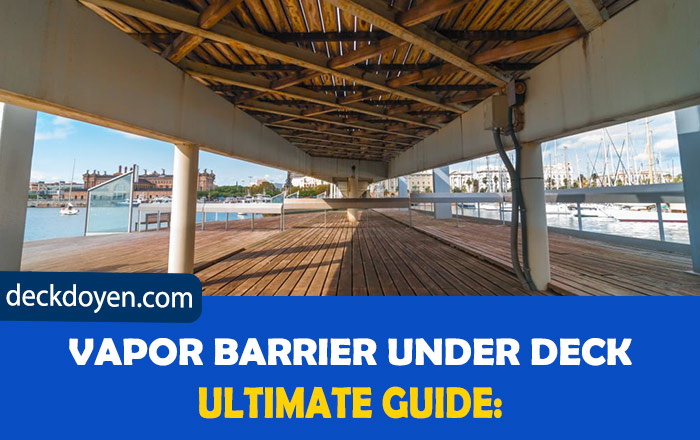Homeowners need to be very thoughtful about the sustainability and protection of their wooden decks. A little moisture and negligence toward moss and fungal growth can destroy their lifetime investment. Therefore, many homeowners want to know whether they should install a vapor barrier under their deck.
Installing a deck vapor barrier is an inexpensive way to protect your property from moisture and mold damage. Consider other options, such as gravel or plastic sheeting, to catch seeped-in water in outdoor conditions for an even more effective measure.
A deck vapor barrier can play a vital role in safeguarding the worth of your property and deck framework. However, before installing it, you must understand its conditional benefits and drawbacks. I have also compiled a few other cost-effective alternative ways to make your project worth it!
What Are The Benefits Of An Underdeck Vapor Barrier:
There are a lot of reasons to indicate that installing a vapor barrier at the time of deck building is a perfect decision. To count them in, here are the highlights:
Have you felt a stinking odor in your recently constructed deck over a basement room? This stinking odor is due to the moisture and condensation that builds up between your deck joists. The smell gets locked in your wooden floor, further damaging the wood. Thus, an underdeck vapor barrier will keep away this smelly odor by forming a perfect seal between your deck joists and stopping moisture from entering.
If you’re not careful, mold can easily grow in moist environments. Even if you mop up spills quickly, there’s no guaranteed way to prevent your wood floors from being affected by the humidity rising from below. If you don’t install a top-of-the-line vapor barrier under your decking, moss could start growing within months of installation.
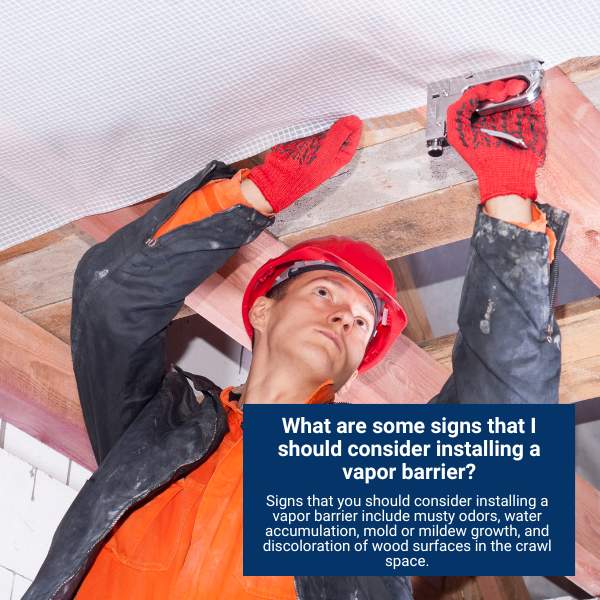
Not only can water vapor cause your deck finish to deteriorate, but it may also ruin the flooring material and damage the adhesives holding your deck together. A vapor barrier will protect against these issues by insulating against drafts and temperature changes.
It helps homeowners save energy as well. It reduces energy consumption by keeping your home cool during summer days or warm during winter months, reducing the workload of air conditioners and heating systems.
So, if you want your deck to stay durable with very low maintenance requirements must use a vapor barrier below it. It also prevents discoloration and oil-based deck stains from flaking out due to the higher humidity levels below the surface. Besides, it also keeps your electrical circuit free from water-related accidents and damages.
Drawbacks Of Vapor Barrier:
Though all these benefits are attractive, you must never install an under-deck vapor barrier over an outside deck. There are some drawbacks below.
Installing a vapor barrier requires special techniques and consideration of weather conditions. It is also important to use the right type of material to ensure that it is not affected by extreme temperatures or moisture, as an outside deck has to go through rain, sunlight, and snow.
Additionally, as they are installed underneath your deck, they can be difficult to access and maintain if any repairs need to be made. Finally, depending on the size of your deck, vapor barriers can be expensive and time-consuming to install.
It is essential to weigh the benefits and disadvantages carefully before deciding whether installing a vapor barrier for your deck is worth it for you. If you choose this route, make sure you hire a professional who understands these installation techniques in order to get the best results.
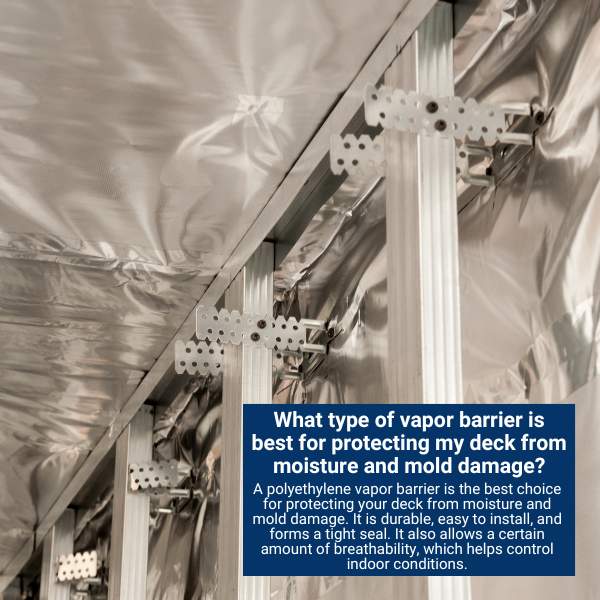
If you can’t afford to install a vapor barrier, there are still ways to protect the wood of your deck from moisture. You should ensure that air circulation is adequate under the deck – this can be done by installing ventilation fans or cutting openings on the underside of your deck so that air continues to circulate.
Additionally, you might also want to consider waterproofing sealants and finishes as well as a rain diverter in order to keep large amounts of water away from the area beneath the deck. All these solutions will help protect your deck from damage caused by excessive moisture.
Finally, if possible, try raising the grade around your house so that more water can drain away from your foundation and not collect under your deck.
How To Install Vapour Barrier:
Don’t forget to prevent moisture before it becomes an issue. Add more insulation and a vapor barrier to the structure to reduce future damage and prevent moisture from entering the crawlspace or under the porch. Let’s understand how you can do it yourself.
1. Measure the area of the crawl space and purchase enough 6 mil polyethylene vapor barrier slightly larger than this area to cover it.
2. Place the vapor barrier on a flat surface and spread it out evenly, with the smooth side facing up.
3. Lay out pieces of scrap wood on top of the vapor barrier so that you can use them as guides when cutting the material.
4. Cut the polyethylene around each piece of wood using a sharp utility knife or scissors.
5. Lift one edge of the cut polyethylene and begin taping down that edge first using wide, waterproof tape ( duct tape is not recommended).
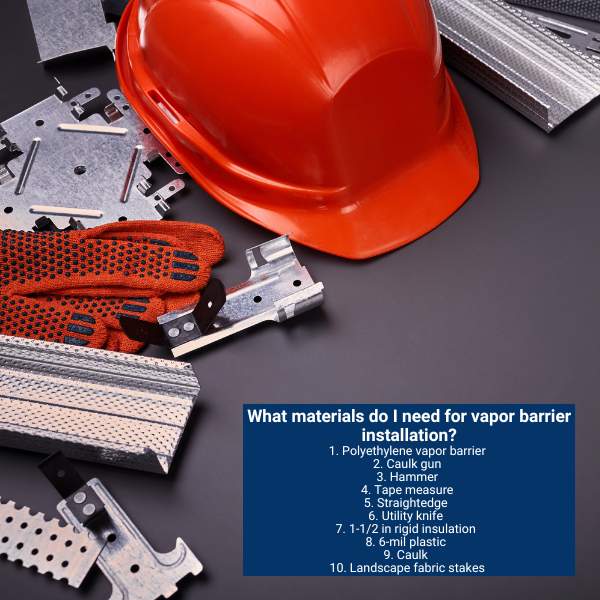
6. Place the barrier in the crawlspace, overlapping all seams by at least 6 inches and taping any exposed edges to ensure an airtight seal and that creases stay as flat and wrinkle-free as possible.
7. Trim any excess material with a sharp utility knife and seal the edges of the trim using waterproof tape.
8. Use landscape stakes or other heavy objects to hold down the vapor barrier and ensure it is properly sealed against all walls, floor joists, and other surfaces within your crawlspace.
9. Make sure that there are no gaps or openings around pipes or other penetrations through which moisture can enter your home. For extra protection against moisture seeping through, use a polyurethane sealant to apply around any joints between pieces of plastic sheeting and the edges of the space. Once this has dried, check for any further gaps that may have appeared.
10. Inspect any seams to make sure they are sealed so moisture won’t get through from outside.
With proper installation, you can now enjoy improved air quality and insulation without worrying about future problems related to moisture!
Tip: If you have a deck exposed to different weather and humidity and built over a slope. You can fill the underneath space with pea-sized or crushed gravel. It will keep your under-deck space free from moisture in the air. Besides, the ventilation will also help keep your deck free from vapor.
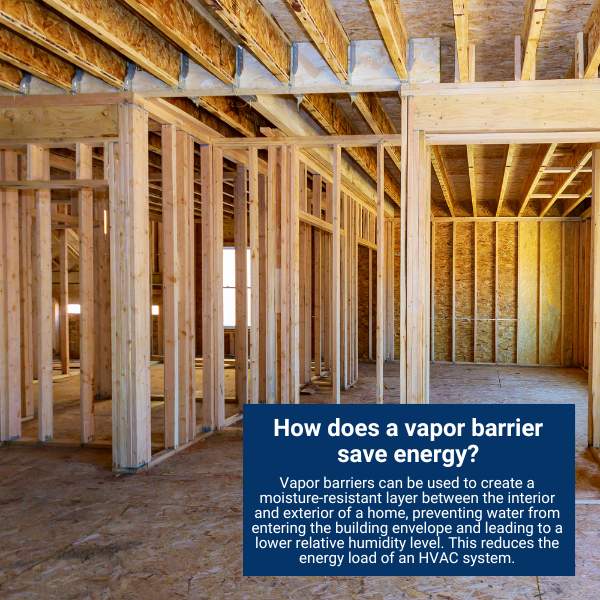
Final Words:
By taking the time to install a vapor barrier, you can ensure that your deck is protected from moisture damage and enjoy improved air quality and insulation. Installing a vapor barrier may seem like an extra expense, but it is worth it, in the long run, to protect your deck and property from potential water damage.
Take the necessary steps now and enjoy the peace of mind that comes with knowing your deck is protected for years to come. It will increase durability and save money from unnecessary repairs and water damage. Additionally, remember that it prevents fungal growth. That is the biggest enemy of your deck.
The benefits are now clear, but the choice is yours. Take control of your property today and enjoy a healthy, waterproof deck tomorrow!

